|
|
|
Sort Order |
|
|
|
Items / Page
|
|
|
|
|
|
|
| Srl | Item |
| 1 |
ID:
118204
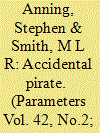

|
|
|
| 2 |
ID:
103423
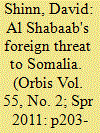

|
|
|
|
|
| Publication |
2011.
|
| Summary/Abstract |
This article focuses on the threat to Somalia by al Shabaab (The Youth), an extremist organization that controls most of southern and central Somalia. It learned its strategy and tactics from al Qaeda and the Taliban and relies heavily on a relatively small number of foreign fighters, most of whom are Somalis with foreign passports from the large Somali diaspora. The non-Somali contingent probably numbers only about 200 to 300, although it brings battlefield experience from Afghanistan and Iraq and provides al Shabaab with expertise in bomb making, remote-controlled explosions, suicide bombing and assassinations. Some of the foreigners occupy key positions in al Shabaab. The connection between al Shabaab and al Qaeda is growing stronger but has not yet reached the level of operational control by al Qaeda. Al Shabaab's draconian tactics, which are imported from outside and are anathema to most Somalis, and its foreign component may be its undoing.
|
|
|
|
|
|
|
|
|
|
|
|
|
|
|
|
| 3 |
ID:
118805
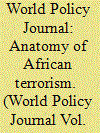

|
|
|
| 4 |
ID:
123508
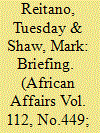

|
|
|
|
|
| Publication |
2013.
|
| Summary/Abstract |
SOMALIA IS NAVIGATING THE MOST PROMISING LANDSCAPE for peace and stability that the blighted country has seen in more than two decades. The successful political transition that culminated in the creation of a federal republic, the election of a broadly representative national government headed by a cadre of invested civil society leaders, and a rollback of the militant terrorist group Al-Shabaab are promising signs for the future. However, there are a number of factors that will restrict the capacity of the central state to coalesce effectively and assert its role. Al-Shabaab, while eroded and increasingly fragmented, still has considerable capacity to trigger violence and instability, as the June car bombing of the UN compound demonstrated. The structure of the state remains incomplete, with little progress on formalizing the constitution and establishing the electoral process, and a number of major points of contention remain, including the movement to establish a new regional Jubaland state to the west of Mogadishu.
|
|
|
|
|
|
|
|
|
|
|
|
|
|
|
|
| 5 |
ID:
171208


|
|
|
|
|
| Summary/Abstract |
Over a decade of security force assistance (SFA) initiatives to build an effective Somali National Army (SNA) failed because of the interrelated effects of political, contextual and operational challenges. The key political challenges were interest asymmetry between international actors and Somali elites, insufficient focus on institution-building and a lack of donor coordination. The principal contextual challenges in Somalia were the legacies of two decades of state collapse and the negative effects of clan dynamics. The main operational challenges were building an army while simultaneously fighting a war, the complexities of military integration, and the severe capability gaps afflicting the SNA.
|
|
|
|
|
|
|
|
|
|
|
|
|
|
|
|
| 6 |
ID:
139118


|
|
|
|
|
| Summary/Abstract |
From 2006 to 2011, al Qaeda's East African proxy, al Shabaab, served as de facto ruling party of Somalia despite the efforts of the internationally recognized Transitional Federal Government (TFG). During these five years, a violent struggle between al Shabaab and the Burundian and Ugandan Peacekeepers of the African Union Mission in Somalia (AMISOM) resulted in thousands of dead civilians, hundreds of thousands of internally displaced persons, and a strategic environment inhospitable to reconciliation, recovery, or development. Beginning in August 2011, AMISOM was able to break the deadlock and force al Shabaab from Mogadishu, then subsequently, Kismayo, and ultimately to consolidate and reorganize in the Somali hinterland. In order to continue the momentum, the African Union and other partner nations must support the newly recognized Somali Federal Government (SFG), neutralize al Shabaab, and provide good governance to its constituents. Al Shabaab's revenue streams must be shut down and their offensive capability must be degraded while the strategic environment is shaped to ensure that conditions conducive to a revival do not exist. Failure to do so will likely see Somalia continuing to produce Islamic extremists and pirates to menace international maritime traffic in the Western Indian Ocean, destabilize East Africa, and adversely impact millions.
|
|
|
|
|
|
|
|
|
|
|
|
|
|
|
|
| 7 |
ID:
156018


|
|
|
| 8 |
ID:
132201
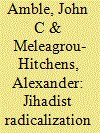

|
|
|
|
|
| Publication |
2014.
|
| Summary/Abstract |
Al-Shabaab, the Somali militia currently fighting against African forces in Somalia, has seen varying degrees of success in its regional recruitment efforts. As it continues to struggle against the forces of the African Union Mission in Somalia (AMISOM), the militia has tried to step up these efforts. To this end, the group has seen significant success in countries such as Kenya, while it has struggled in Somaliland. The strategies and tactics employed by al-Shabaab in order to successfully recruit vary depending on geographical location, as do the motivations to join, and drawing on fieldwork in both Kenya and Somaliland this study will compare and contrast the effectiveness al-Shabaab recruitment in both of these countries. In doing so, it will examine which local conditions either enhance or limit these efforts, identifying some of the determinants of the success and failure of jihadist recruitment in east Africa.
|
|
|
|
|
|
|
|
|
|
|
|
|
|
|
|
| 9 |
ID:
123000
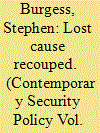

|
|
|
|
|
| Publication |
2013.
|
| Summary/Abstract |
A constitutional convention with representation from clan elders adopted a new constitution for Somalia on 1 August 2012, which paved the way for the election of a federal parliament and a new president of the Federal Republic of Somalia. This article examines two opposing explanations for this progress in a country long dismissed as a lost cause. Bottom-up stability, with grassroots equilibrium, is argued to be more likely to bring representation and renewal. The counter-hypothesis emphasizes security from the top down as more likely to lead to representation and renewal. Both hypotheses are evaluated here based on peacebuilding theory and evidence from Somalia and other relevant cases, including Afghanistan and the Democratic Republic of Congo (DRC). This review concludes that top-down security was possible and desirable in Somalia, paving the way for continued security efforts and stability work. The strategy of the African Union, European Union, and United States - supporting Burundi, Kenya, and Uganda with high-salience peace enforcement in Somalia - succeeded in bringing greater top-down security. The article explains that a combination of international assistance and training and increased combat effectiveness forced Al Shabaab out of Mogadishu and other urban centres. Western governments and international organizations continue to pursue top-down security as the best hope for ending war and restoring peace in Somalia. Top-down security, if properly implemented, can pave the way for bottom-up stability efforts and renewal and representation in Somalia, Africa, and elsewhere.
|
|
|
|
|
|
|
|
|
|
|
|
|
|
|
|
| 10 |
ID:
151772


|
|
|
| 11 |
ID:
156015
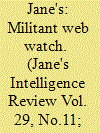

|
|
|
| 12 |
ID:
131164
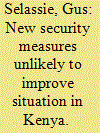

|
|
|
| 13 |
ID:
107327


|
|
|
|
|
| Publication |
2011.
|
| Summary/Abstract |
The election of Sheik Sharif Sheik Ahmed as the transitional president of Somalia was the climax of the United Nations (UN)-led Djibouti peace process. The election, it was hoped, would herald the beginning of the reconstitution of the Somalian state. Unfortunately, nearly three years after the event, that has still not happened. The government of Sheik Sharif has faced a number of challenges which are yet to be resolved. In the end, the Djibouti peace process has not guaranteed a stable and functional national government in Somalia.
|
|
|
|
|
|
|
|
|
|
|
|
|
|
|
|
| 14 |
ID:
131136


|
|
|
|
|
| Publication |
2014.
|
| Summary/Abstract |
From late 2012, the African Union Mission in Somalia (AMISOM) had adopted a largely defensive posture, citing limited resources as the principal reason for this. However, increasing numbers of Al-Shabaab attacks both inside and outside Somalia have forced AMISOM and its partners to open a new phase in the war against the group. To that end, in November 2013 the UN Security Council called for AMISOM to be enhanced in several areas and in January 2014 the mission adopted a new Concept of Operations. These developments facilitated a new wave of offensive operations conducted in tandem with the Somali National Security Forces. Nevertheless, AMISOM still confronts some familiar - and fundamental - challenges in its efforts to stabilise Somalia.
|
|
|
|
|
|
|
|
|
|
|
|
|
|
|
|
| 15 |
ID:
131126
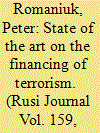

|
|
|
|
|
| Publication |
2014.
|
| Summary/Abstract |
At the intersection between crime and security, the study of how terrorist groups and networks finance their activities is crucial both to an overall understanding of their operation and to counter-terrorist activities. Peter Romaniuk explores the progress made by academic research in establishing the scope of the subject matter, identifies the shortcomings of existing research, and highlights fruitful avenues for future investigation - and how this can in turn help policy-makers and practitioners to focus their counterterrorism
efforts.
|
|
|
|
|
|
|
|
|
|
|
|
|
|
|
|
| 16 |
ID:
118807
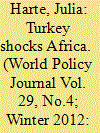

|
|
|
|
|
| Publication |
2012.
|
| Summary/Abstract |
Istanbul-Late one August night in 2011, Rifat Saricaoglu, the head of Turkey's association of private universities, received a call from the office of the prime minister. Saricaoglu had three hours to gather as many university scholarship pledges for Somali students as possible. Prime Minister Recep Tayyip Erdogan was about to fly to Mogadishu, making the first visit to Somalia by a non-African head of state since the country's last effective government was ousted in 1991, and Erdogan wanted to present a momentous gift.
|
|
|
|
|
|
|
|
|
|
|
|
|
|
|
|
| 17 |
ID:
154256


|
|
|
|
|
| Summary/Abstract |
Somalia has the longest coastline in Africa and a wealth of marine resources. However, weak governance, lack of infrastructure and illegal, unregulated and unreported (IUU) fishing by foreign countries have impeded Somali efforts to take full advantage of the economic potential of these resources. The overfishing caused by IUU vessels has decreased the domestic catch, forcing local fishermen to turn to piracy. The increase in piracy has been mirrored by Al-Shabaab terrorist activity. Despite the different motivations of these two groups, profits from piracy have been used to fund terrorist activity and the two groups have become intertwined. This article reviews the case of overfishing in Somalia, its fostering of piracy and explores the link between piracy and Al-Shabaab. It suggests that nationwide economic stability and peace could be furthered with the improved management and development of Somali marine resources.
|
|
|
|
|
|
|
|
|
|
|
|
|
|
|
|
|
|
|
|
|